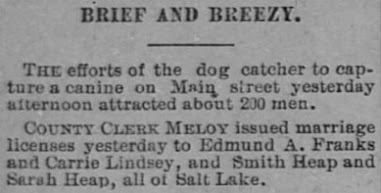Smith Heap was born in Lancashire, England, in 1825. He joined the LDS Church in 1840, married Alice Parker - also of Lancashire - in 1846, and arrived in New Orleans aboard the ship Argo in 1850.
The Heaps settled in St Louis, where they had seven more children, before moving to Utah territory around 1862. There they took part in the short-lived Muddy Mission, and lived in St George, Minersville, and Monroe.
After Alice passed away in 1882, Smith Heap moved to Salt Lake City, where he lived until his death. He was married to two more women in this period, Marie Kirstine Nielsen and Sarah Matthews May (polygamously? - this is a bit of a mystery, as you'll see below).
The area was being settled with some enthusiasm at the time, but lack of water and other difficulties has left Widtsoe a ghost town today. Located about 16 miles north of Bryce Canyon, the entire valley holds just the few souls needed to operate a few large-scale agricultural operations.
The Heaps settled in St Louis, where they had seven more children, before moving to Utah territory around 1862. There they took part in the short-lived Muddy Mission, and lived in St George, Minersville, and Monroe.
After Alice passed away in 1882, Smith Heap moved to Salt Lake City, where he lived until his death. He was married to two more women in this period, Marie Kirstine Nielsen and Sarah Matthews May (polygamously? - this is a bit of a mystery, as you'll see below).
Heap is buried in the Salt Lake City Cemetery in an unmarked grave.
Why am I interested in Smith Heap?
Well, Smith Heap was father of Martha Ann Heap Anderson, who was mother of Valda Naomi Anderson Pope, who is my great-grandmother. They lived near my grandparents in Kanab and I visited their home many times as a child.
I always have the idea that the bare facts of biography and government records tell but a fraction of a person's story. The Washington County Historical Society indexed a number of newspaper articles referring to Smith Heap over the years - and boy howdy do they confirm that theory.
Why am I interested in Smith Heap?
Well, Smith Heap was father of Martha Ann Heap Anderson, who was mother of Valda Naomi Anderson Pope, who is my great-grandmother. They lived near my grandparents in Kanab and I visited their home many times as a child.
I always have the idea that the bare facts of biography and government records tell but a fraction of a person's story. The Washington County Historical Society indexed a number of newspaper articles referring to Smith Heap over the years - and boy howdy do they confirm that theory.
"In the late 19th and early 20th centuries, a number of temperance bars were established in conjunction with various temperance organisations. Originally, these advocated a moderate approach to life, especially concerning the consumption of alcohol. Later they moved toward abstinence from alcohol. Temperance bars with full temperance licenses (allowing them to serve on Sundays despite English trading laws) were once common in many high streets and shopping areas in the North of England. The temperance movement had a massive following, fueled mainly by nonconformist Christian denominations, such as Methodists.Temperance bars were the first outlet for the drinks Coca-Cola and Vimto in the early 20th century. They were also sometimes called 'temperance taverns'."
--Wikipedia, entry "Temperance bar", https://en.wikipedia.org/wiki/Temperance_bar
Why was there a particular interest in temperance drinks in Salt Lake City in the 1880s and 90s? Paul. H. Peterson writes:
William H. Dixon recorded in 1865 that while abstinence from wine and tobacco is recommended by young and taught in the mormon schools we found cigars in many houses and wine in all except in the hotels. . . . Mormons were temperate and moderate but not abstinent. (pp. 67-68)
Beginning in 1880 and lasting throughout the remainder of the eighties a great prohibition wave swept the country. . . . At the same time the prohibition issue was being hotly debated throughout the nation, the Mormon church initiated in 1883 the most zealous widespread and probably most influential crusade to encourage church members to obey the Word of Wisdom. (p. 69)
In short, with these "temperance drinks," Heap was catering to a trend that was sweeping not only the nation, but Utah as well.
1892, A Peck O' Trouble:
Sen-sen was a popular breath mint at that time, with a strong licorice flavor and scent. It was often used to cover up the smell of smoking and drinking. It was very popular in the 1930s through 1960s, and still manufactured and sold until 2013.
If Heap were operating the same kind of business today, we would probably call it a "convenience store" or similar.
Mary Jane Heap Worthen was Smith and Alice Heap's second daughter and third child.
Martha Anderson was Smith and Alice Heap's first daughter and second child.
"Mrs. Mark Pope" was Valda Anderson Pope, my great grandmother. The Popes homesteaded in the Johns Valley near the town of Widtsoe in 1914 - joining a number of Pope relatives in the effort to settle the area.
In 1926, the valley still held a small community, including a church and schools, though not a high school. That was the year the Popes moved from Johns Valley to Kanab to pursue work and so that LaVee - their oldest daughter and my grandmother - could attend high school.
I knew them there in the 1960s and early 1970s, when I was a small child and they were in their late 70s and early 80s.
 |
| Valda and Mark Pope |
 |
| With Baby Brent, 1963 |






















